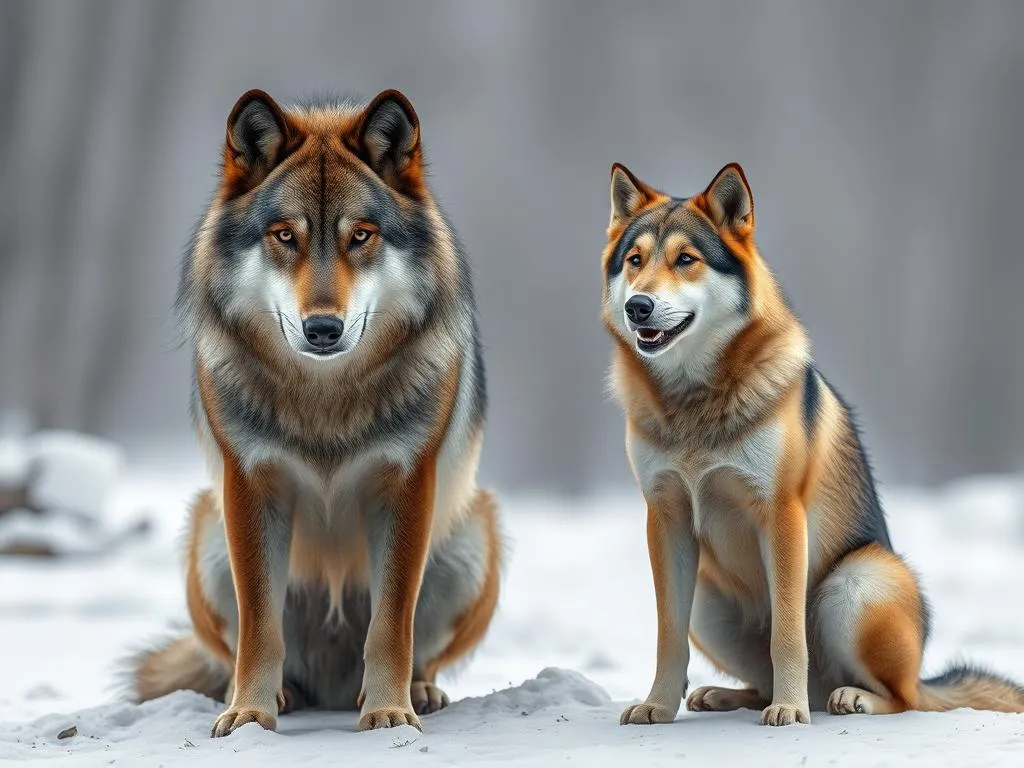
Wolves and dogs share a fascinating evolutionary relationship, with dogs being domesticated descendants of wolves. The size differences between these two canines are significant and vary widely, depending on the specific breeds of dogs and the species of wolves. Understanding these differences is crucial for dog owners, enthusiasts, and anyone interested in the natural world. This article delves into the details, providing a thorough comparison of how big wolves are compared to dogs, while dispelling common myths along the way.
Understanding Wolves
General Characteristics of Wolves
Wolves are majestic creatures known for their strength, intelligence, and complex social structures. Physically, they are characterized by a thick double coat of fur, which helps them adapt to various climates. Their fur can range from gray to brown, and even black or white in some species. Wolves typically have large, expressive eyes that can be yellow, amber, or even blue, depending on the individual.
Wolves live in packs, which are usually family units that work together to hunt and raise their young. They are highly social animals with a structured hierarchy, which helps them thrive in the wild.
Size Variations Among Wolf Species
Gray Wolves
The gray wolf is the most recognized species, primarily found in North America, Europe, and Asia. On average, gray wolves weigh between 50 to 110 pounds and stand about 26 to 32 inches tall at the shoulder. Males are generally larger than females. Their size allows them to take down prey that is much larger than themselves, which is essential for their survival.
Arctic Wolves
The arctic wolf, a subspecies of the gray wolf, has adapted to the cold climates of the Arctic tundra. These wolves are slightly smaller than their gray counterparts, averaging between 75 to 100 pounds and standing around 24 to 28 inches tall. Their smaller size helps them conserve heat while still being powerful hunters.
Other Species
Other wolf species, such as the red wolf and the eastern wolf, also exhibit different sizes. Red wolves typically weigh between 45 to 90 pounds and stand around 26 to 32 inches tall. Eastern wolves can weigh between 50 to 100 pounds. Each of these species showcases unique traits and adaptations to their environments, contributing to the overall diversity of wolves.
Understanding Dogs
General Characteristics of Dogs
Dogs are one of the most diverse species on the planet, featuring hundreds of breeds that vary significantly in size and characteristics. This diversity stems from thousands of years of domestication and selective breeding for specific purposes, such as herding, hunting, and companionship. Generally, dogs possess a wide range of fur types, colors, and body shapes, making them unique among domesticated animals.
Size Variations Among Dog Breeds
Small Breeds
Small dog breeds, such as Chihuahuas and Pomeranians, typically weigh between 2 to 10 pounds and stand around 6 to 12 inches tall at the shoulder. Their compact size makes them popular among city dwellers and those looking for a low-maintenance pet.
Medium Breeds
Medium-sized breeds, including Beagles and Cocker Spaniels, usually weigh between 20 to 60 pounds and stand about 12 to 18 inches tall. These dogs are often valued for their versatility and adaptability in various living conditions.
Large Breeds
Large breeds like German Shepherds and Golden Retrievers weigh between 50 to 90 pounds and stand around 20 to 26 inches tall. They are often used as service dogs due to their intelligence and trainability.
Giant Breeds
Giant breeds, such as Great Danes and Mastiffs, can weigh over 100 pounds and stand between 28 to 34 inches tall at the shoulder. Their imposing size is matched by their gentle temperament, making them beloved family pets.
Size Comparison: Wolves vs. Dogs
Average Size Metrics
When comparing the sizes of wolves and dogs, it’s essential to look at average metrics. Adult gray wolves typically stand about 26 to 32 inches tall at the shoulder and weigh between 50 to 110 pounds. In contrast, the size of dogs varies widely:
- Small breeds: 6 to 12 inches tall, 2 to 10 pounds
- Medium breeds: 12 to 18 inches tall, 20 to 60 pounds
- Large breeds: 20 to 26 inches tall, 50 to 90 pounds
- Giant breeds: 28 to 34 inches tall, 100+ pounds
In general, wolves are larger than most dog breeds, but there are exceptions, particularly among the giant breeds.
Comparative Visuals
Visual aids can enhance understanding. Infographics or charts showing size differences are effective tools. For instance, a comparison chart could display the height and weight of a typical gray wolf alongside that of a Great Dane, illustrating how wolves are generally more robust despite the presence of giant dog breeds.
Including photos of wolves next to common dog breeds can also provide context. A gray wolf standing next to a German Shepherd highlights the size differences, with the wolf appearing bulkier and taller.
Factors Influencing Size
Several factors influence the size of both wolves and dogs. In dogs, genetics and breeding play a crucial role. Selective breeding has led to the development of various breeds with specific size traits. For instance, the Chihuahua was bred for its small size, while the Great Dane was bred for its height.
In wolves, size is influenced by natural selection and adaptation to their environments. Larger wolves may thrive in colder climates, where size helps conserve heat, while smaller wolves might be more agile in warmer habitats.
Behavioral Implications of Size Differences
Physical Activity and Exercise Needs
The size of an animal often correlates with its physical activity levels and exercise needs. Wolves, being natural hunters, require extensive physical activity to maintain their health. They roam vast territories and engage in long-distance running to hunt prey. This instinctual behavior demands a higher level of endurance and physical fitness.
Dogs, on the other hand, have varying exercise needs based on size. Small breeds may require less vigorous exercise, while large and giant breeds often need more substantial physical activity. Understanding these needs is crucial for responsible pet ownership.
Training and Socialization
Training challenges can arise with larger breeds compared to wolves. While wolves exhibit natural behaviors that may be difficult to train out, larger dog breeds can sometimes share similar challenges, like stubbornness or high energy levels. Socialization is also key; larger dogs may need more structured training to ensure they behave appropriately around smaller animals and people.
Differences in social behavior stem from size as well. Wolves have complex social structures within packs, relying on hierarchy and communication. Dogs, while social animals, often adapt their behaviors to human-led environments, which can simplify their interactions.
Myths and Misconceptions
Common Myths About Wolves and Dogs
Many myths surround the relationship and differences between wolves and dogs. One common misconception is that all wolves are aggressive and that their size makes them dangerous. In reality, wolves are generally shy and avoid human contact unless they feel threatened.
Another myth concerns size; some believe that all dog breeds are smaller than wolves. While most dogs are smaller, certain giant breeds can rival or exceed the size of some wolves.
Realities Behind the Myths
Scientific studies have clarified many of these misconceptions. For example, research shows that wolves tend to avoid confrontations with humans, and their size does not inherently dictate aggression. Understanding these realities is essential for fostering respect and appreciation for both species.
Conclusion
In summary, the question of how big wolves are compared to dogs reveals a fascinating array of size differences influenced by species, breed, and environmental adaptations. While wolves are generally larger than most dog breeds, exceptions exist among giant breeds. Understanding these differences is vital for responsible pet ownership and appreciation of both animals.
The diversity within the canine family is a testament to the remarkable adaptability of these creatures, whether in the wild or as beloved companions. By recognizing and respecting these differences, we can better appreciate the unique qualities that each species brings to our lives.









